
Hi Gang…
Where did each of our fiberglass sports cars come from?
Here at Forgotten Fiberglass, we are discussing the design heritage of the cars we’ve come to love. We’ve even created a “Design Heritage” category that you can search using the “category box” on the right side of our website. This is an important historical aspect of our favorite cars, and we want to make it easy for all of us to access this information easily. Click here to review design heritage and how it’s important to each of our fiberglass specials.
The Importance of Design Heritage:
The design heritage of each of cars is a growing area of interest for many folks becoming more fascinated with the history of fiberglass specials of the 1950s. From the Glasspar G2 and its Jaguar XK120 heritage, to the Victress S1 and its 1939 BMW 328 Mille Miglia Buegelfalte roadster heritage, and even most recently to the Bangert Manta Ray and it’s relationship to both the 1954 Buick Wildcat concept car AND the special bodied Chrysler Maserati built in the mid ‘50s – all fiberglass specials are receiving more attention each and every day.
The design heritage of each of our cars – where the styling came from and what it was influenced by – is an important component of the history of each of these cars, and one that helps us better understand the car and its context in time. We will leave no fiberglass matte unturned in our pursuit of the history of these cars and where their stylistic influences came from.
But it’s a rare day, indeed, here at Forgotten Fiberglass when we can identify the exact car that was used in the creation of any of our fiberglass specials. But…with the help of Bill Burke, Bill Pollack, and other legendary figures from the ‘50s, we know that the exact Cisitalia 202 coupe that the mold was taken off of to create the Allied Swallow. It was the Cisitalia owned by Bob Petersen of Petersen Publishing that he bought in the summer of ’52.
Let’s dive in gang!
Going Cisitalia Hunting…
Where did the Cisitalia come from that was used as the Allied / Atlas “donor” car? It was the Cisitalia 202 Coupe brought back from the east by Bill Pollack for new owner – Bob Petersen – publisher of Motor Trend, Hot Rod, and other automotive publications. And…in recent conversations with both Bill Burke and Bill Pollack, more information surfaced – and it’s that information I’m sharing with you “fans of fiberglass” today.
First, Petersen was bringing back the Cisitalia he had just bought to debut as part of his 3rd annual November 1952 Petersen Motorama. Bill Pollack who was a consummate race car driver and the Advertising Manager of “Auto Speed and Sport” magazine at the time, a Petersen Automotive publication, was asked to travel to Boston to pick up the car and drive it back to California. This was in the Summer of ’52.
Luckily, we have his notes on the trip back with this car – and a few photos too – all published in an article in Auto Speed and Sport by Pollack which highlighted his odessey from Boston to Los Angeles piloting the Cisitalia.
Let’s see what Bill Pollack had to say about shepherding this car cross-country back in the summer of ’52.
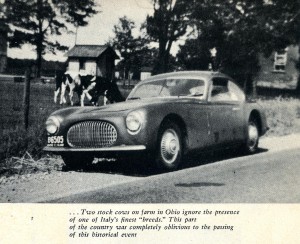 From The Commons To California By Cisitalia…The Hard Way
From The Commons To California By Cisitalia…The Hard Way
Auto Speed and Sport: September 1952
By Bill Pollack
Note: We had intended to give our readers a complete Auto-Trial of the Cisitalia after Bill Pollack had delivered it to the West Coast, but the car needed so many little adjustments to bring it up to top performance that the project was dropped. In a future issue of Auto we will present the Cisitalia Auto-Trial just as soon as this little bomb is ready. -Editor
Pioneers did not have to worry about parts for their horses and oxen. Wagons are made of wood. Trees are wood, therefore they are potential parts for the wagons. Head gaskets for Cisitalias do not grow on trees. With this little logic acquired from years of study, I started out in a Cisitalia coupe from Boston for Los Angeles. The car was vintage 1948 from a sunny hill in Italy. The engine was small, even by continental standards.
One day of preventive maintenance was spent at Hansen-MacPhee in Bedford, Mass., where some of the minor ills of the car were cured. It was found that the drysumped oil system had a remarkable affinity for the radiator. This was probably due to some relation between the head and the gasket, but, since this peculiar arrangement worked in our favor (except for the cost of the oil), it was decided to attempt the trip.
In spite of the double oil consumption, cooling engine and lubricating same, the gas mileage was very good. The car used only 3.2 gallons during the first 109 miles through traffic from Boston to Hartford, Conn. Encountering rather nasty weather, I continued through New York and arrived 15 hours and 50 minutes later in Pittsburgh.
Driving along the Pennsylvania Turnpike, I crossed the Ohio line and had the oil changed. This caused some comment, especially when I drained the radiator and told the man I would try water in it for a change.
Cedar Rapids, Iowa, would be a much nicer town if it had a Cisitalia service agency. It was here that a much-used clutch throw-out bearing decided to protest. Since the next 1000 miles were mostly prairie country, I decided to continue, feeling that the bearing would last as long as it liked anyway. The approach of thunderstorms and possible hail brought our second period of driving to a halt after some 25 hours on the road. The second stop was made in Cipher, Iowa, “the town that offers nothing.”
Gassing up the car for the third stage of the trip, I answered the usual questions of why the car’s speedometer went up to 200 mph. The instrument is calibrated in kilometers and my usual answer was that trying to read an instrument calibrated in Mach one, Mach two, etc. was too difficult on these bumpy roads. Later on this same question was more easily answered by a bloodshot stare.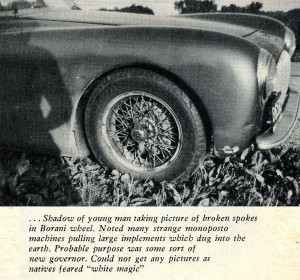
The Cisitalia had beautiful hub caps very carefully perforated for the purpose of venting air from the brakes. I am also inclined to think that they vent spokes. Shortly after losing one of these hubs at speed, the same wheel developed a thump which forced a halt. An inspection revealed that the inside spokes had sheared. This left me with five tires and four wheels.
The John Deere Tractor Co. has never utilized the practicality or the beauty of Borani wheels, hence there was a short supply of them in the farming area which surrounded me. Continuing, I decided I would write Sr. Ascari and tell him I knew exactly how he felt at Indianapolis.
The complete absence of wind noise and the perfect handling of this car make long periods of driving possible. The car has no tendency to veer on crown roads and the extremely accurate steering made it possible to miss most of the bumps. The handling of the car is comparable to flying a good airplane…you simply think where you want to go and without any perceptible movement, the machine does the rest.
Approaching Cheyenne, Wyoming we climbed to about 6000 ft. and the thunder storms that had been threatening in the distance now welcomed us into their fold. As the intensity of the storms increased, my enthusiasm waned and I decided to rest. Five hours later I rose to check the weather and found that an endless of variety of storms would be covering the Continental Divide.
While refueling at the local trading post, I was again approached with the usual questions, including an offer from one man, who wanted to breed the Cissy with his quarter horse and went off mumbling something about the Irish sweepstakes and frontal area.
The Continental Divide, in the middle of the Wyoming plains, is the highlight of some of the most desolate country in the United States. It is inhabited solely by ex-Allard drivers with a small contingent of TC enthusiasts, who act as liaison officers with the rest of the world.
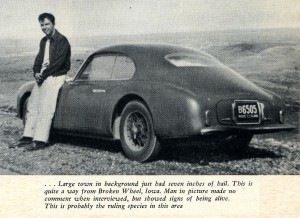 Leaving this land of Indians and passionate horses, I climbed to 8800 ft. over the Cheyenne Pass. It was here that I saw some of the most inspiring sights of the trip. I drove into the base clouds of the thunder storms and then above them to see each storm throwing bolts of power in every direction.
Leaving this land of Indians and passionate horses, I climbed to 8800 ft. over the Cheyenne Pass. It was here that I saw some of the most inspiring sights of the trip. I drove into the base clouds of the thunder storms and then above them to see each storm throwing bolts of power in every direction.
But for the accompaniment of Moussorgsky’s “Night on Bald Mountain,” this could have been a Disney fantasy. The grim amputated trees in every direction gave mute testimony to the strength of the surrounding giants.
The crossing of the Divide was made to the tune of three inches of rain and seven inches of hail in a nearby town. The windshield wipers on the Cissy had been set for a mild Italian rain; in this storm the time lag from wipe to wipe conveyed a feeling of waiting for a television channel to resume the video portion of its picture. Provo, Utah, was warm, so I stopped.
The last part of our trip from Provo to Los Angeles was made without stop. Eighty miles from Las Vegas (“how much for a Cisitalia on a hard-way eight?”) trouble begat trouble. Some member of a party to overthrow Cisitalias had blithely inserted 80 lbs. of air into my right front tire. This was discovered when the shock on my left front wheel came off, for which act I offer no explanation.
The last 400 miles of a trip are always considered the most difficult and my case proved the axiom. Approaching Los Angeles, my speed increased like that of a pair of horses running home. As the lights on the Cissy began to grow dimmer, the tired feeling in the power plant seemed to indicate that we had been a little too hopeful.
The car was smoking so badly that I felt sure the head gasket would leave us. After the first traffic came the city lights, then my street. While pulling into my steep driveway I stalled the engine. When I tried to restart it, the battery was dead.
Thoughts on The Article:
Bill Pollack is an excellent writer, and what a fun article this is to read today 🙂 I can feel his frustration and determination – especially having made many cross country trips with cars myself. But my travels were in a Chevrolet Suburban post the year 2000. Bill’s travels were an adventure in the golden era of sports cars in postwar America. Bill Pollack wins again with this story of cross country conundrums.
So thanks to Bill Pollack, we know some of the specifics of the car and time. Petersen bought the car in the Summer of ’52, it was brought back (under great difficulty as you can tell from the story above) from Boston, Massachusetts to Los Angeles California and dropped off at George Barris Custom Shop for paint and bodywork. Bill Pollack remembers the car was originally silver in color. That’s when Bill Burke – legendary builder and driver of postwar race cars and another Petersen Automotive associate comes in.
According to Bill Burke, molds were secretly taken off of the Cisitalia in the late Summer / early Fall of ’52. Part of the way we can confirm this timeframe is the lag between the story by Pollack we are highlighting today (published in September, 1952) and the appearance of second story of Atlas and their fiberglass bodies being available as told in the December ’52 issue of Motor Trend. Research is such fun!
During this time, Bill Burke was already getting proficient with ‘glass. His first fiberglass creation, was already in magazines having appeared in the September 1952 issue of Hot Rod – a fiberglass bodied “O” class streamliner with a frame built of PBY wing strut tubing. You “Allied” owners out there should recognize this construction – it’s the same tubing he used to built all of the Allied / Atlas factory frames sold with the Allied cars – when ordered.
So the Allied Swallow which debuted to the world in December ’52 Motor Trend was Burke’s second fiberglass car – and the second one where he used PBY tubing for the chassis. Pretty neat gang! But we’re not finished revealing new information. Read on….
Bill Pollack and Auto Sportsman Magazine, June 1953
Bill Pollack has the patience of saint. Each time I’ve talked with him he’s been ready, willing, and able to help with any detail needed. Thanks, Bill, for working with me at every step in our research here at Forgotten Fiberglass 🙂
What Bill shared was that Petersen’s finished Cisitalia 202 coupe was also shown in 1953 on the cover of Auto Sportsman Magazine. How neat! This is a little known magazine that was an extension of “Auto Speed and Sport” but only ran for 4 issues. Getting a copy took some time, but here it is scanned for your enjoyment today.
At the Barris shop, Petersen had George change the color from a silver to a brown – or near brown color. The car and the model look stunning in the photo, and the location of the photos was none other than the home office of Petersen Publishing. In fact, the car was photographed near the same spot in the office where the photos of the Fred Bodley Motor Trend Victress were taken that are shown in the 1955 Victress brochure (3 photos of this car are shown in the Victress ’55 brochure).
Where Is This Cisitalia Today?
No one knows where this exact car is today. But for any aficionado from the Cisitalia registry, there may be some clues. According to the story above, the year of the car is 1948 – and as can be clearly seen in photos in both magazines – it was a right-hand drive car. I can’t imagine that someone would have changed this configuration from right to left-hand drive over the years, so this might help focus research in this area.
Also, the car was brought to Boston, Massachusetts early in its life, and the color was originally silver. Then it was changed to the color above, and may have been metallic, too (think of a showcar at the Petersen Motorama gang – probably a stunning looking car and color on the floor of the Pan Pacific auditorium at November weekend). So if any Cisitalia owners out there have some heritage of these colors on their right-hand drive cars – you might have the car shown above.
Summary:
So that’s it – the story of the car and how it came to be selected and used as the basis of Bill Burke’s entry into the fiberglass field – the first Allied Swallow coupe. A neat window back into time that shows us how one of our fiberglass cars originated so many years ago. Now all we have to do is see if this bronze colored right-hand drive Cisitalia surfaces. What fun that would be!
Thanks again to Bill Pollack and Bill Burke for their help in researching this article.
Hope you enjoyed the story, and until next time…
Glass on gang…
Geoff
——————————————————————-
Click on the Images Below to View Larger Pictures
——————————————————————-
- From Hot Rod Magazine, September 1952
- From Hot Rod Magazine, September 1952
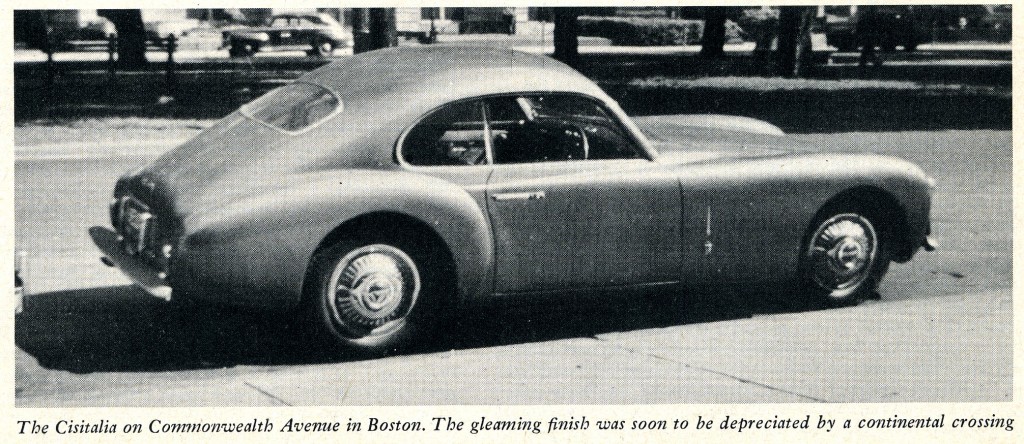
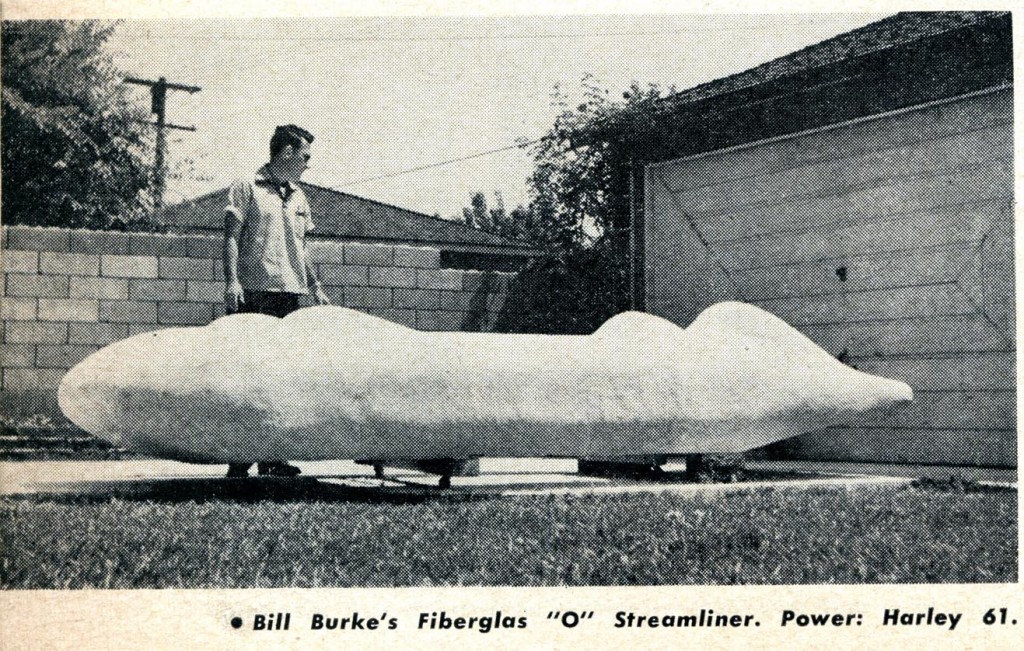
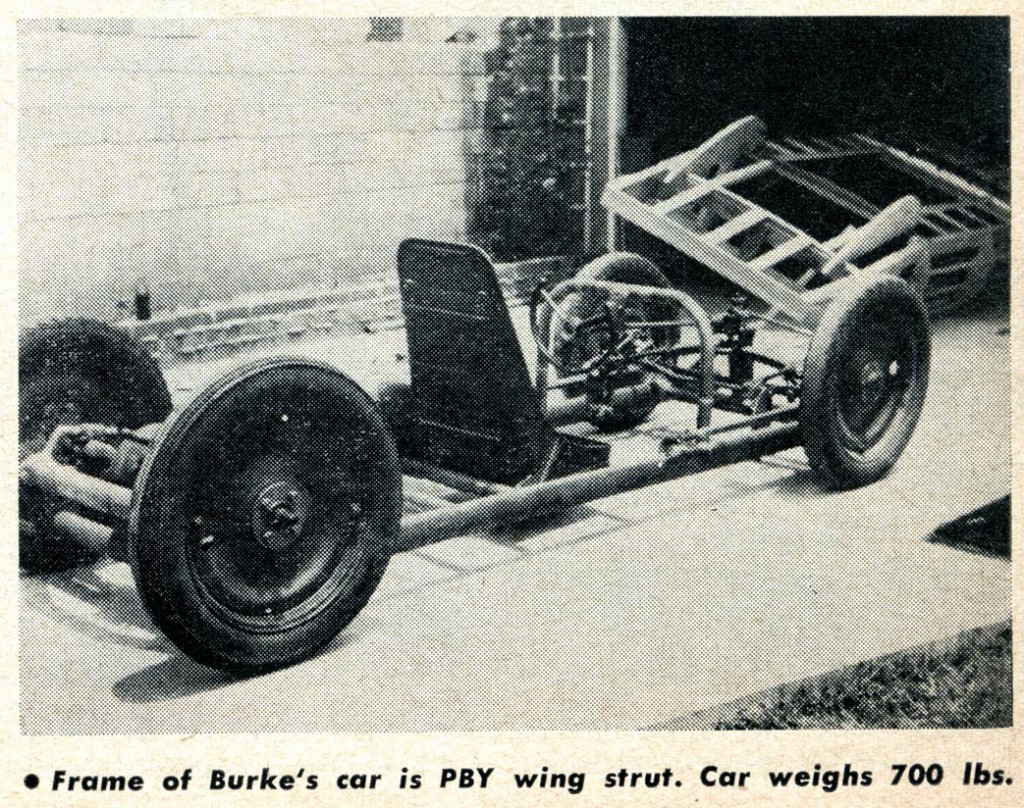
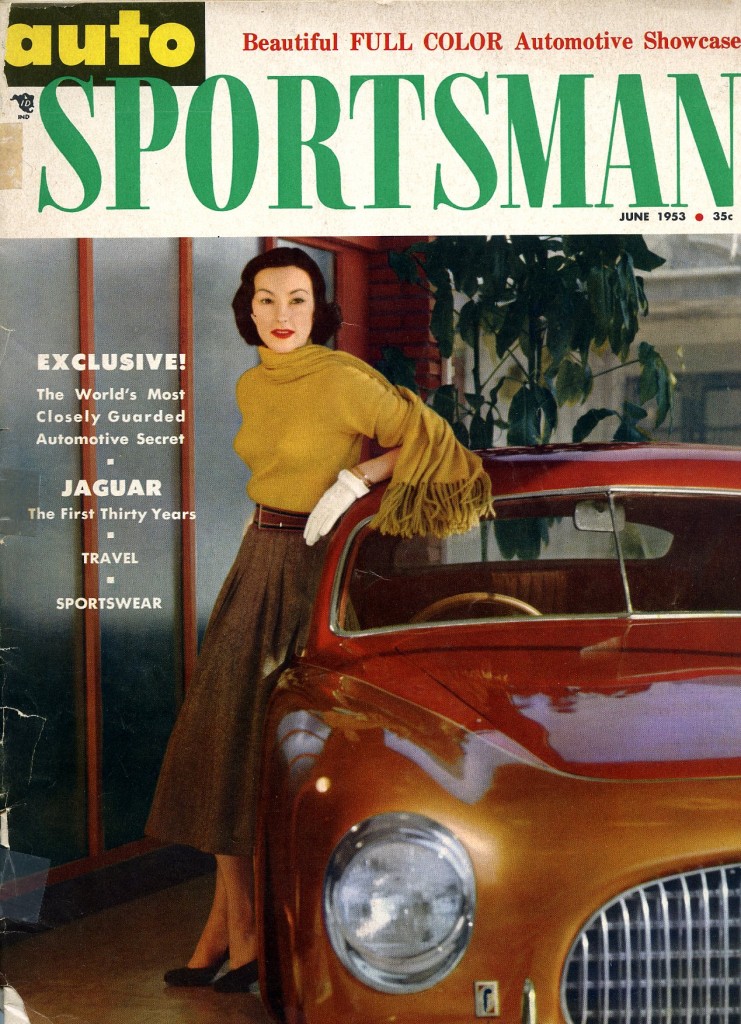












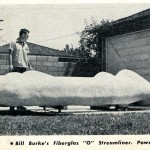
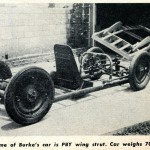
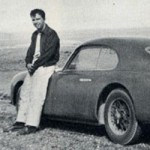
Brandon (BDK)…no. Leslie Kendall (Petersen Curator) and I have not been able to track down the original car so far. The provenance of the car still awaits us…Geoff
So this isn’t the car in the Petersen collection now?
A very interesting story Geoff! And best of all…I got a new car to add to my list of cars worked on by Barris Kustoms 🙂